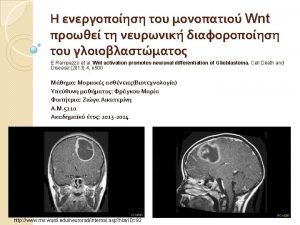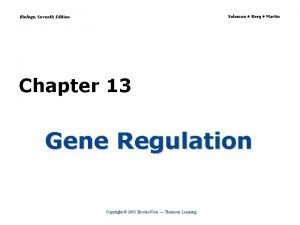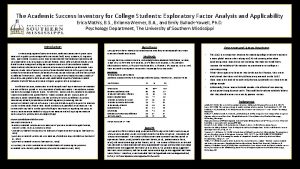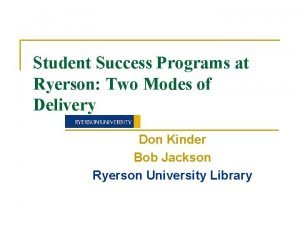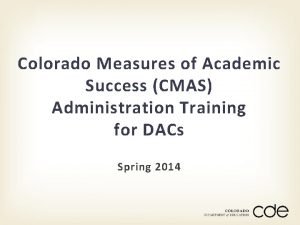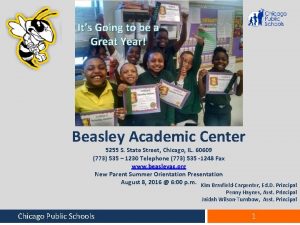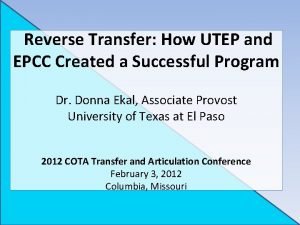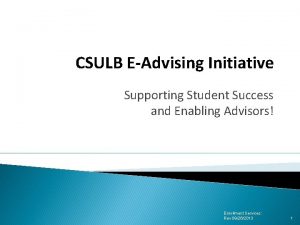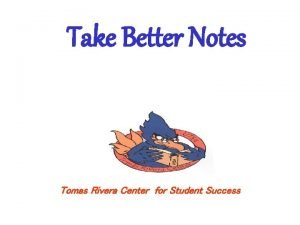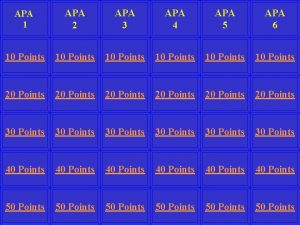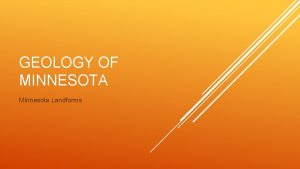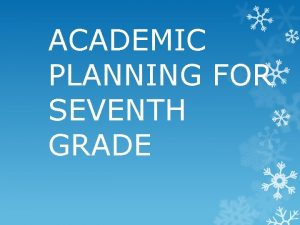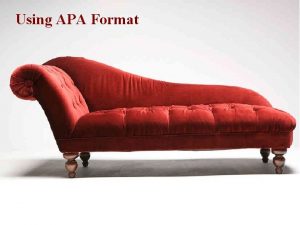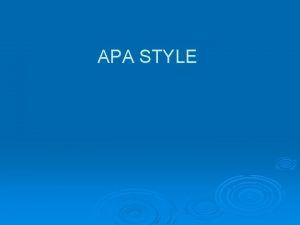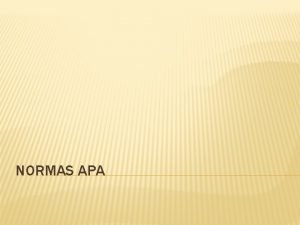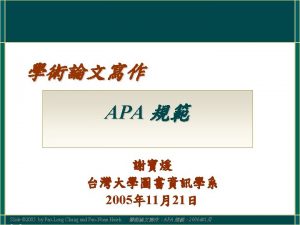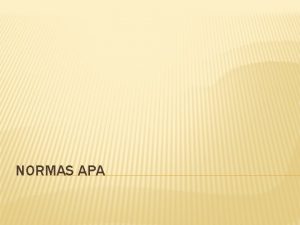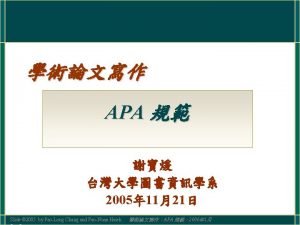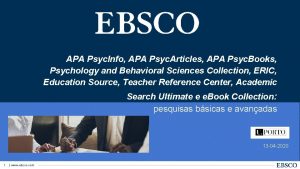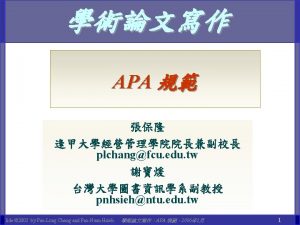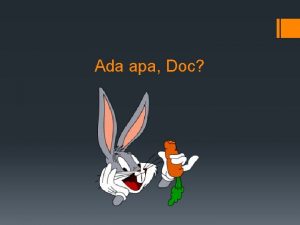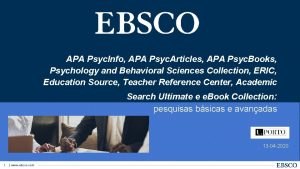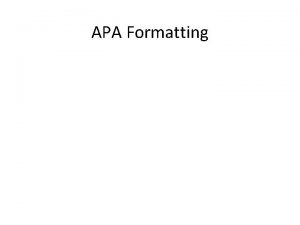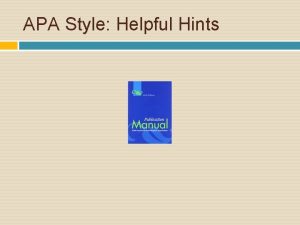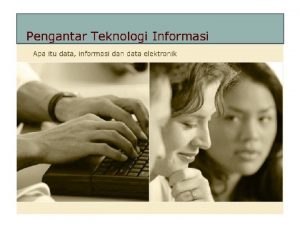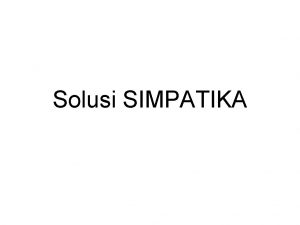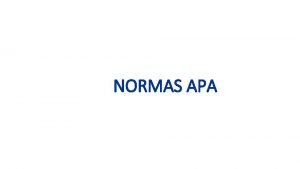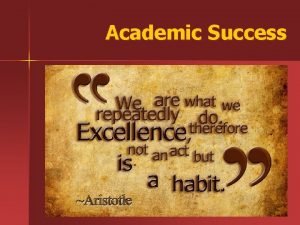APA Seventh Edition Center for Academic Success Minnesota

























- Slides: 25

APA Seventh Edition Center for Academic Success Minnesota State University, Mankato

Overview This presentation outlines several noteworthy changes to the updated Publication Manual of the American Psychological Association (2020). In general, the changes to the Publication Manual reflect current practices for improving readability, accessibility, and inclusion in written work. While this presentation is not inclusive of ALL changes, it highlights many that are significant to writers using APA style. Writers should consult the updated APA website and Publication Manual for a comprehensive list of updates.

Overview Hyperlinks to the APA website https: //apastyle. apa. org are included for quick access. These hyperlinks are found within section numbers or chapter numbers in parenthesis, for example (2. 3). Links to short demonstration videos are also included for your convenience.

Quick Index of Noteworthy Changes • Two formatting options for the title page: professional and student (2. 3) • New sample papers for professional and student writers (Chapter 2) • Updated running head (2. 8) • Flexibility with font choices (2. 19) • Bold type for all heading levels (2. 26; 2. 27) • Omission of the “Introduction” section heading (2. 27) • Endorsement of “singular they” for gender inclusion (4. 18) • Updated guidelines on bias-free language (Chapter 5)

Quick Index of Noteworthy Changes • Double quotation marks, instead of italics, used for examples and ironic expressions (6. 7) • In-text citations with three or more authors name the first author and et al. on the first mention (See p. 63 and 8. 17 in printed Publication Manual) • Up to 20 authors are now named before using an ellipsis for works with multiple authors on the reference page (APA Blog and 9. 8) • Expanded examples for citing Twitter, Facebook, Instagram, TED Talks, You. Tube, and other social media and audio/video sources (some examples online 10. 12; 10. 15. Comprehensive list of examples in printed Publication Manual 10. 12; 10. 15) • New formatting for URLs and DOIs on reference page (9. 34 -9. 36) • Publication location no longer included for book references (10. 2)

Expanded Explanations of APA Updates The following slides expand upon the quick index in the previous slides.

Formatting Student and Professional Papers The seventh edition of the Publication Manual (2020) provides separate guidelines formatting the title pages of student and professional papers. Video: Formatting Student Title Page Video: Formatting Professional Title Page New student and professional Sample Papers from the APA website

Formatting Student Papers (2. 3) • The running head is completely omitted from student papers. Only the page number appears in the header. • The entire paper is double-spaced. • Students should allow 3 to 4 double-spaced blank lines at the top of the title page before typing the title of their work in bold font. • Following the bolded title should be • • • A blank double-spaced line The author name(s) The student’s school affiliation The name and number of the course The instructor’s name The due date, written in the typical style for their country

Formatting Professional Papers (2. 3) • The words “Running head” are omitted from the title page. The title in all caps should appear in the header flush left on all pages, and the page numbers should be flush right. • The entire paper is double-spaced. • Writers should allow 3 to 4 double-spaced blank lines at the top of the title page before typing the title of their work in bold font. • Following the bolded title should be • • A blank double-spaced line Name(s) of the author(s) Affiliation Author Note

Other Formatting Changes • Font choices (2. 19) • Calibri 11, Arial 11, Georgia 11, Lucinda 10, and Times New Roman 12 are allowed, in addition to a few others (2. 19) • Bolded heading levels to increase readability • See 2. 27. Watch video. • Omission of the “Introduction” section heading (2. 27) • The section heading “Introduction” is no long used. It is assumed that introductory material will begin the essay; therefore, this section heading is not needed. The title of the paper at the beginning of the paper’s body functions as the first level one section header.

Singular “They” Pronouns Section 4. 18 in the printed Publication Manual (2020) states “Writers should always use the singular ‘they’ to refer to a person who uses ‘they’ as their pronoun (see Section 5. 5 for more on gender and pronoun usage). Also use ‘they’ as a generic third-person singular pronoun to refer to a person whose gender is unknown or irrelevant to the context of the usage” (p. 120).

Singular “They” Pronouns The following endorsed usage examples are taken directly from section 4. 18 of the printed Publication Manual. Additional examples are found online (4. 18). Each participant turned in their questionnaire. Jamie shared their experiences as a genderqueer person. A child should learn to play by themselves [or themself] as well as with friends. Rowan, a transgender person, helped themselves [or themself] to the free coffee. (p. 121)

Bias-Free Language Guidelines Chapter 5 of the Manual of Style (2020) provides advice for avoiding bias in academic writing. The section topics for Chapter 5 are summarized below: 5. 1: Be specific and relevant. Use words to describe characteristics that are relevant and distinguishing among people. Be specific about age ranges, types of conditions, gender identity, origins and affiliations of people, sexual orientation, and socio-economic status. 5. 2: Use mindful labels: Refer to people using the labels they choose for themselves and labels that are respectful. Use “person-first” language. For example, use “people who use cocaine” rather than “cocaine-users. ”

Bias-free language guidelines 5. 3: Give specific ages ranges: “ 55 -65” rather than “ 55 and older” 5. 4: Use relevance and person-first language when writing about disabilities. Only mention a disability if it is relevant to the topic. Use “person with a disability” rather than “disabled person. ” Exceptions to this exist, and Section 5. 4 should be consulted directly to avoid bias. 5. 5: Gender identity—explanation of terms to avoid bias

Bias-free language guidelines 5. 6: Research participants—explanation of terms to avoid bias 5. 7: Racial and Ethnic Identity—explanation of capitalization and terms 5. 8: Sexual orientation—discussion of relevance and terms 5. 9 Socioeconomic status—discussion of reporting and terms 5: 10 Intersectionality—using language sensitive to intersectionality

Punctuation updates and clarifications • One space should follow a period (6. 1) • Double quotation marks, instead of italics, are used to set off examples, key terms, irony, or slang (6. 7) Examples: Correct: The key terms covered were “anthropomorphism” and “metaphor. ” Incorrect: The key terms covered were anthropomorphism and metaphor.

In-text Citation for Three or More Authors In-text citations of three or more authors should name the first author and “et al. ” on the first mention and all subsequent mentions. Example: (Sarafine et al. , 1986) should be used for the authors M. L. Sarafine, R. G. Crowder, and B. H. Repp. (p. 63 and 8. 17)

Reference Citation: Up to 20 Authors • Up to 20 authors are now named before using an ellipsis for works with multiple authors on the reference page An example of how to cite 21 authors is given here.

Audio/Video and Social Media References: New Examples Are Given in 7 th Edition New reference examples provided on APA website: You. Tube, Twitter, Facebook Some online examples not found here may be found on the APA Blog https: //apastyle. apa. org/blog New examples provided in the printed Manual of Style (2020): Blog post, Wikipedia entry, Mobile app, Podcast, Webinar, TED Talk, You. Tube, Twitter, Facebook, Instagram, Online forum

URL and DOI Reference Updates • Section 9. 36 in the Manual of Style (2020) states “When a DOI or URL is long and complex, you may use short. DOIs or shortened URLs if desired. Use the short. DOI service provided by the International DOI Foundation (http: //shortdoi. org/) to create short DOIs” (p. 300). Also-“Any shortened URL is acceptable in a reference as long as you check the link to ensure that it takes you to the correct location” (p. 300).

URL and DOI Reference Updates (9. 36) • Both URLs and DOIs now appear as hyperlinks in citations. • The words “retrieved from” are omitted. • When citing websites, the website name is now included in the reference citation whenever it differs from the author’s name.

Ebooks (10. 2) • When citing Ebooks, the device (such as Kindle) is not named. (Manual of Style, p. 321)

Book References (10. 2) • The location of publication is no longer included for book references. Example: Serefine, M. L. (1988). Music as cognition. Columbia University Press.

APA Style Resources • https: //apastyle. apa. org/blog • Publication Manual of the American Psychological Association

References American Psychological Association. (2020). APA style. https: //apastyle. apa. org American Psychological Association. (2020). APA style blog. https: //apastyle. apa. org/blog American Psychological Association. (2020). Publication manual of the American Psychological Association (7 th ed. ). https: //doi. org/10. 1037/0000165 -000
 Manny contomanolis
Manny contomanolis Iowa state academic success center
Iowa state academic success center Academic success center
Academic success center Human anatomy and physiology seventh edition marieb
Human anatomy and physiology seventh edition marieb Database system concepts seventh edition
Database system concepts seventh edition Information management principles
Information management principles Molecular biology of the cell seventh edition
Molecular biology of the cell seventh edition Biology seventh edition
Biology seventh edition Academic success inventory for college students
Academic success inventory for college students Continuing academic success
Continuing academic success Ryerson academic success centre
Ryerson academic success centre Cmas test nav
Cmas test nav Your child's success or lack of success
Your child's success or lack of success Your child's success or lack of success
Your child's success or lack of success Using mis (10th edition) 10th edition
Using mis (10th edition) 10th edition Using mis 10th edition
Using mis 10th edition Beasley academic center
Beasley academic center Nature explore workshops
Nature explore workshops Consortium agreement utep
Consortium agreement utep Ucua csulb
Ucua csulb Tomas rivera center
Tomas rivera center Uncp center for student success
Uncp center for student success Kontinuitetshantering
Kontinuitetshantering Typiska drag för en novell
Typiska drag för en novell Nationell inriktning för artificiell intelligens
Nationell inriktning för artificiell intelligens Ekologiskt fotavtryck
Ekologiskt fotavtryck






